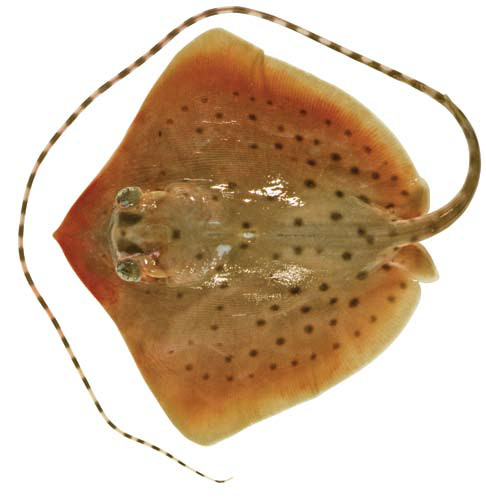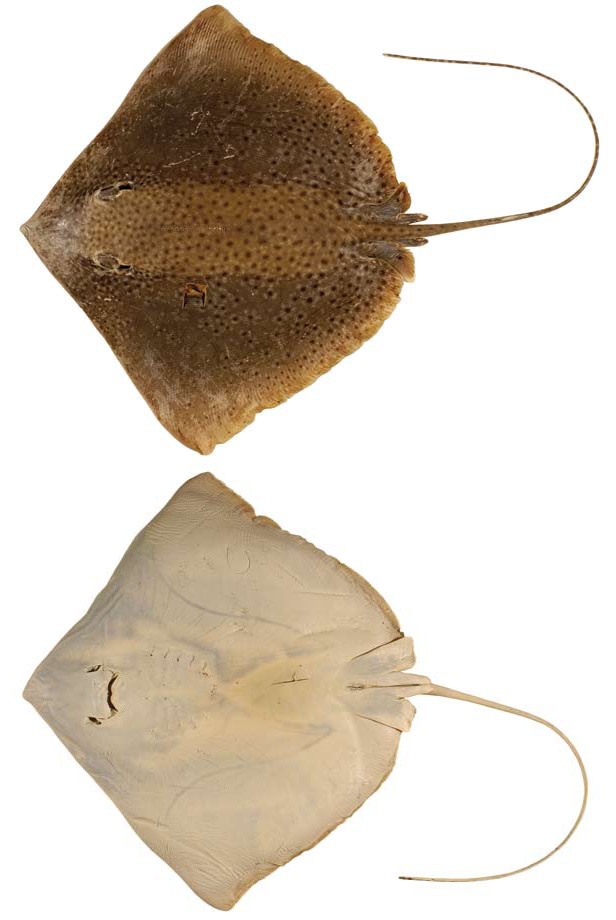Maculabatis astra
(Last, Manjaji-Matsumoto & Pogonoski, 2008)
Classification: Elasmobranchii Myliobatiformes Dasyatidae
Reference of the original description
Himantura astra sp. nov., a new whipray (Myliobatoidei: Dasyatidae) from northern Australia. CSIRO Marine and Atmospheric Research Paper, 22, 303–314
Himantura astra sp. nov., a new whipray (Myliobatoidei: Dasyatidae) from northern Australia. CSIRO Marine and Atmospheric Research Paper, 22, 303–314
Image of the original description

Dorsal view of: A. Maculabatis astra sp. nov. juvenile male paratype (CSIRO H 3373–02, 177 mm DW, fresh); In: Last, P.R. & Manjaji-Matsumoto, B.M. & Pogonoski, J.J. (2008): Himantura astra sp. nov, a new whipray (Myliobatoidei: Dasyatidae) from northern Australia. CSIRO Marine and Atmospheric Research Paper, 22: 303-314

Dorsal view of: A. Maculabatis astra sp. nov. juvenile male paratype (CSIRO H 3373–02, 177 mm DW, fresh); In: Last, P.R. & Manjaji-Matsumoto, B.M. & Pogonoski, J.J. (2008): Himantura astra sp. nov, a new whipray (Myliobatoidei: Dasyatidae) from northern Australia. CSIRO Marine and Atmospheric Research Paper, 22: 303-314
Synonyms / new combinations and misspellings
Himantura astra, Himantura cf. astra, Maculabatis cf. astra
Himantura astra, Himantura cf. astra, Maculabatis cf. astra
Types
Maculabatis astra
Himantura astra
Holotype: CSIRO: H 3377-01; Paratype: CSIRO: T 700; CSIRO: H 964-02; CSIRO: T 698; CSIRO: H 959-04; CSIRO: H 959-02; CSIRO: H 959-01; CSIRO: H 635-04; CSIRO: H 635-03; CSIRO: H 635-01; CSIRO: H 5589-01; CSIRO: H 3387-02; CSIRO: H 3381-03; CSIRO: H 3381-02; CSIRO: H 3381-01; CSIRO: H 3380-02; CSIRO: H 3380-01; CSIRO: H 3373-09; CSIRO: H 3373-08; CSIRO: H 3373-03; CSIRO: H 3373-02; CSIRO: H 1222-02; CSIRO: CA 4271; CSIRO: CA 2406; CSIRO: T 699; CSIRO: H 964-01; CSIRO: H 5588-01; CSIRO: H 5204-01; CSIRO: H 38-01; CSIRO: H 3387-03; CSIRO: H 3373-01; CSIRO: H 3369-01; CSIRO: H 3352-01; CSIRO: H 3329-01; CSIRO: H 3322-02; CSIRO: H 322-01; CSIRO: H 312-01; CSIRO: H 1222-01;
Maculabatis astra
Himantura astra
Holotype: CSIRO: H 3377-01; Paratype: CSIRO: T 700; CSIRO: H 964-02; CSIRO: T 698; CSIRO: H 959-04; CSIRO: H 959-02; CSIRO: H 959-01; CSIRO: H 635-04; CSIRO: H 635-03; CSIRO: H 635-01; CSIRO: H 5589-01; CSIRO: H 3387-02; CSIRO: H 3381-03; CSIRO: H 3381-02; CSIRO: H 3381-01; CSIRO: H 3380-02; CSIRO: H 3380-01; CSIRO: H 3373-09; CSIRO: H 3373-08; CSIRO: H 3373-03; CSIRO: H 3373-02; CSIRO: H 1222-02; CSIRO: CA 4271; CSIRO: CA 2406; CSIRO: T 699; CSIRO: H 964-01; CSIRO: H 5588-01; CSIRO: H 5204-01; CSIRO: H 38-01; CSIRO: H 3387-03; CSIRO: H 3373-01; CSIRO: H 3369-01; CSIRO: H 3352-01; CSIRO: H 3329-01; CSIRO: H 3322-02; CSIRO: H 322-01; CSIRO: H 312-01; CSIRO: H 1222-01;
Description :
Citation: Maculabatis astra (Last, Manjaji-Matsumoto & Pogonoski, 2008): In: Database of modern sharks, rays and chimaeras, www.shark-references.com, World Wide Web electronic publication, Version 04/2024
Please send your images of "Maculabatis astra" to info@shark-references.com

Maculabatis astra, adult male holotype (CSIRO H 3377–01, 589 mm DW, preserved): dorsal view; ventral view. In: Last, P.R. & Manjaji-Matsumoto, B.M. & Pogonoski, J.J. (2008): Himantura astra sp. nov, a new whipray (Myliobatoidei: Dasyatidae) from northern Australia. CSIRO Marine and Atmospheric Research Paper, 22: 303-314

Maculabatis astra, adult male holotype (CSIRO H 3377–01, 589 mm DW, preserved): dorsal view; ventral view. In: Last, P.R. & Manjaji-Matsumoto, B.M. & Pogonoski, J.J. (2008): Himantura astra sp. nov, a new whipray (Myliobatoidei: Dasyatidae) from northern Australia. CSIRO Marine and Atmospheric Research Paper, 22: 303-314
Common names
 Black-spotted whipray
Black-spotted whipray
 Black-spotted whipray
Black-spotted whipray
Short Description
Original diagnosis after LAST, MANJAJI-MATSUMOTO & POGONOSKI, 2008 [3355]: A species of Himantura distinguished by a combination of the following features: disc rhomboidal, trunk not greatly thickened; preorbital snout moderately long, with a weak apical lobe, angle 102–112°; lateral apices moderately angular to narrowly rounded; orbits moderately large, protruded slightly; tail with deep longitudinal groove on mid-ventral surface and prominent ridge along its mid-lateral edge; primary denticle band present in postnatal juveniles (exceeding 200 mm DW) and larger; secondary denticle band subrectangular, with well-defined lateral margins, band extending along trunk from preorbital and onto tail, its maximum width subequal to interspiracular width; band fully developed by 480 mm disc width; dorsal surface with diffuse dark brown spots or specks, spots extending onto tail to stinging spine base; distance between spots more than diameter of largest spot apart; tail banded beyond sting in juveniles (less than 300 mm DW), saddled above and pale ventrally in largest adults; pectoral-fin radials 130–135; total vertebral count (excluding 1st synarcual centra) 94–102, monospondylous centra 43–47, pre-sting diplospondylous centra 50–56.
Original diagnosis after LAST, MANJAJI-MATSUMOTO & POGONOSKI, 2008 [3355]: A species of Himantura distinguished by a combination of the following features: disc rhomboidal, trunk not greatly thickened; preorbital snout moderately long, with a weak apical lobe, angle 102–112°; lateral apices moderately angular to narrowly rounded; orbits moderately large, protruded slightly; tail with deep longitudinal groove on mid-ventral surface and prominent ridge along its mid-lateral edge; primary denticle band present in postnatal juveniles (exceeding 200 mm DW) and larger; secondary denticle band subrectangular, with well-defined lateral margins, band extending along trunk from preorbital and onto tail, its maximum width subequal to interspiracular width; band fully developed by 480 mm disc width; dorsal surface with diffuse dark brown spots or specks, spots extending onto tail to stinging spine base; distance between spots more than diameter of largest spot apart; tail banded beyond sting in juveniles (less than 300 mm DW), saddled above and pale ventrally in largest adults; pectoral-fin radials 130–135; total vertebral count (excluding 1st synarcual centra) 94–102, monospondylous centra 43–47, pre-sting diplospondylous centra 50–56.
Distribution
Indo-West Pacific: Australia, to West Papua, Indonesia; including Timor Sea. Source: www.gbif.org
Indo-West Pacific: Australia, to West Papua, Indonesia; including Timor Sea. Source: www.gbif.org
Remarks
shark-references Species-ID=14649;
shark-references Species-ID=14649;
Parasites (arranged by Jürgen Pollerspöck)
Cestoda
Copepoda
Cestoda
- Acanthobothrium cannoni Campbell & Beveridge, 2002 [26821]
- Prochristianella aciculata Beveridge & Justine, 2010 [17404]
- Prochristianella clarkeae Beveridge, 1990 [17404]
- Stillabothrium jeanfortiae Forti, Aprill & Reyda, 2016 [27352]
- Stillabothrium mariae Ruhnke, Aguilar & Reyda, 2022 [30721]
Copepoda
- Lepeophtheirus acutus Heegaard, 1943 [26229]















